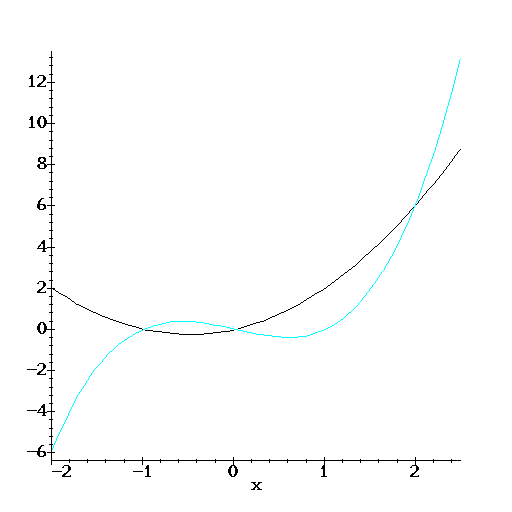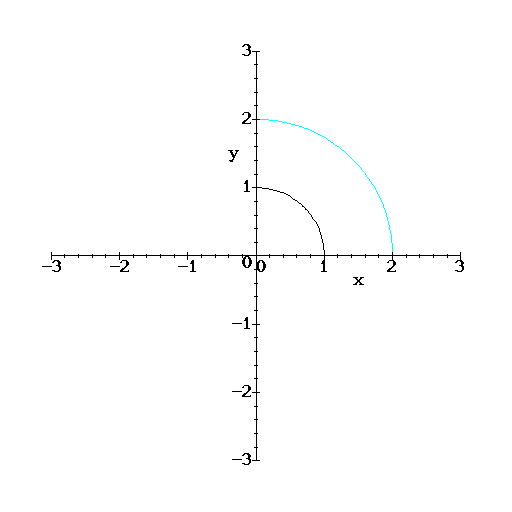The double integral of a function f(x,y) over a bounded region
D (of a general shape, not necessarily a rectangle) is defined
simply as the integral over a rectangle R that contains D of
a function F(x,y) that coincides with f(x,y) inside D but
it takes the value 0 outside D.
 Since we already know how to integrate over rectangles the above trick is all we need as the definition of the integral over (bounded) regions D of general shape.
Notice, that if f(x,y) is non negative the double integral
over D can still be interpreted as the volume that lies
between D and the surface z=f(x,y). If the boundary of
the region D is not too weird, in particular if
it is of one the forms indicated in the figures below,
 the double integrals are given by, |
> R1 := Int(Int(f(x,y),y=g1(x)..g2(x)),x=a..b);
b g2(x)
/ /
| |
R1 := | | f(x, y) dy dx
| |
/ /
a g1(x)
| this is when the region is like the picture on the left. The other case gives, |
> R2 := Int(Int(f(x,y),x=f1(y)..f2(y)),y=c..d);
d f2(y)
/ /
| |
R2 := | | f(x, y) dx dy
| |
/ /
c f1(y)
|
|
Examples
| Compute the double integral of the function, |
> f := (x,y) -> x^3*y^2+x*y: 'f(x,y)' = f(x,y);
3 2
f(x, y) = x y + x y
| over the region D bounded between the curves, |
> h1 := x^2+x; h2 := x^3-x;
2
h1 := x + x
3
h2 := x - x
|
for non negative x.
|
Solution:
| We first find the points of intersection of the two curves, h1 and h2. They intersect when x equals: |
> inter := solve(h1-h2,x);
inter := 0, -1, 2
| The two curves look like this: |
> plot({h1,h2},x=-2..2.5,axes=frame);

| Since we want only the non negative x's, we need to integrate x from 0 to 2. The integral we need to compute is then, |
> Ans1 := Int(Int(f(x,y),y=h2..h1),x=0..2)=int(int(f(x,y),y=h2..h1),x=0..2);
2
2 x + x
/ /
| | 3 2 304576
Ans1 := | | x y + x y dy dx = ------
| | 5005
/ /
0 3
x - x
| and it evaluates to, |
> ans1 := evalf(304576/5005);
ans1 := 60.85434565
|
|
A more interesting problem:
| Consider the region D between the circles of radius 1 and 2 in the first quadrant. Look at the picture below: |
> plot({[cos(t),sin(t),t=0..Pi/2],[2*cos(t),2*sin(t),t=0..Pi/2]}, x=-3..3,y=-3..3);

|
write the double integral of a general function g(x,y) over the region D
as itereted integrals over x and y.
|
Solution2:
| This region is not of the forms considered above. However, the region D can be decompose into two pieces D1 and D2. The piece D1 is for x between 0 and 1 and D2 when x is between 1 and 2. The integral is then equal to: |
> Ans2 := Int(Int(g(x,y),y=sqrt(1-x^2)..sqrt(4-x^2)),x=0..1) +
> Int(Int(g(x,y),y=0..sqrt(4-x^2)),x=1..2);
2 1/2 2 1/2
1 (4 - x ) 2 (4 - x )
/ / / /
| | | |
Ans2 := | | g(x, y) dy dx + | | g(x, y) dy dx
| | | |
/ / / /
0 2 1/2 1 0
(1 - x )